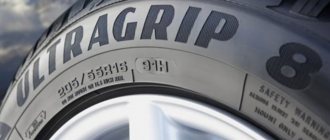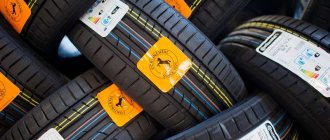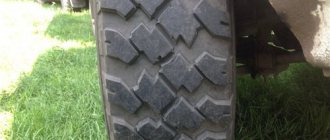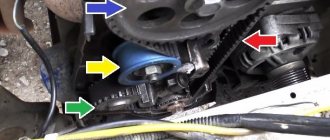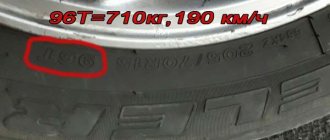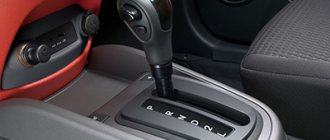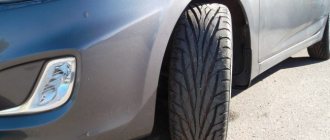What do yellow dots or triangles on tires mean?
The yellow dot on a tire is one of the most common markers, so we start with its description. Thus, based on static balancing, the lightest place on the car tire is established. To understand why this is needed, you need to find the L marking on the sidewall of the rubber.
Thus, we will install the easiest place indicated by the manufacturer. The yellow marker, in turn, will be on the exact opposite side. But there are times when the factory does not put the letter L on the tire.
In such a situation, we place it as follows: the yellow mark should be located next to the nipple through which pumping occurs. This is useful in cases where we need to balance the tire and use as few additional weights as possible.
Red marks
Among others, there is sometimes a red dot on the tire.
The place next to this mark is the heaviest, because this is where the sidewall structure is the most rigid. Scientifically speaking, it is the maximum point of deflection of the radial force. The red triangle mark on the tire indicates the point where the belt layers meet, or the stiffest part of the sidewall. When installing rubber on a wheel rim, the L mark must be aligned with the heavy part, that is, the red mark. Otherwise, it will be quite difficult to “center” the rubber and additional vibrations from the engine and wheels will be felt on the steering wheel.
The question often arises, what to do if there are two colored marks on the tire and they are not located diametrically opposite? In this case, maintenance and repair specialists recommend focusing on the yellow mark, considering the red mark to be of secondary importance.
It is worth saying that the color marks do not carry basic information about the grade or type of tire, but rather represent instructions for proper installation for tire service workers. Therefore, when purchasing tires, you must be guided, first of all, by the technical characteristics of the product, and the presence or absence of color markings is not a critical factor when choosing.
What do red dots and triangles on tires mean?
Colored markings on tires may also be red - what does this mean? As a rule, dots, triangles, and less often circles are applied. They are located opposite the lightest point on the tire and make installation easier for service station workers.
There are situations when the letter L is not on the sidewall. This means that the orange or red mark will be located in the opposite direction from the one where the pumping valve is located.
Tire markings
There are certain labeling standards that any manufacturer must indicate on the tire. These inscriptions are printed on the sidewall of the tire and contain information useful to the buyer. The manufacturer, tire model, and size are indicated in large letters.
There are two types of sizing: European or American. European markings use the metric system and look like this: 185*45*R17. The first number indicates the tread width, the second indicates the profile height, and the third indicates the internal diameter. The letter R stands for radial cord weave.
One American format is similar to the European one, but there are additional letters in front of the numeric values. For example, LT 195*45*R17. These tire designations indicate their area of application (LT – light track, P-passenger, T – track). This allows you to quickly select the appropriate set.
The second American method uses the inch system. The marking 30*10.5*R17 tells the buyer first about the outer diameter of the wheel (30 inches), tread width (10.5) and inner diameter. This method is the most convenient, because the external dimensions of the tire are indicated.
Special attention should be paid to the mark with the load and speed index on the sidewalls of the tires. These marks are placed next to the wheel size and are indicated by a number and a Latin letter, respectively. Like road signs, such signs convey important information to the buyer. The load index tells you how much weight one tire can support. If there are two values on it separated by a hyphen, this means that the tires can be installed in pairs and the first value indicates the load for a single installation, and the second for a double installation. Additionally, there may be an EL (Extra Load) mark, which indicates a reinforced cord weave and the fact that the load index of such tires is three points higher.
The speed index is denoted by a Latin letter. This marking indicates the speed limits that can be achieved on such tires. Everything is simple here - the closer the letter is to the end of the Latin alphabet, the higher the speed value.
The seasonality of tires is important. Summer tires are not designated in any way - if there are no special pictograms on the sidewall, such tires are considered summer. There may be an additional presence of an umbrella icon, rain, the words Aqua or rain, which indicates a developed pattern that allows you to effectively drain water and resist aquaplaning.
All-season tires are marked with the letters M+S or Mud+Snow. Such rubber feels good at average temperatures, but is significantly inferior to profile sets when deviating from average values. Therefore, it is advisable to have two types of seasonal tires, and consider all-season tires as a “transitional set” .
Winter tires are indicated by a snowflake icon or the letter W (Winter). Such sets consist of soft rubber, which does not harden in the cold and clings well to the surface. The buyer can choose between studded or non-studded tires (Velcro).
A studded set is needed only for harsh winters and frequent driving on icy asphalt. If you live in an urban area, then studless tires are sufficient. Depending on the type of climate, you can give preference to Scandinavian tires (cold, snowy winters) or the European equivalent (mild climates).
It also happens that the tires have additional signs in the form of the inscription Rotation, Outside or Inside, arrows indicating the direction of rotation. Such marks are placed on tires with an asymmetrical and directional pattern and indicate the correct location of the wheel, its outer or inner side. All this makes it much easier to install the tire yourself.
Sometimes you can see different colored stripes on tires. In the form of multi-colored lines, stripes, triangles, squares or seals. These strips carry interesting information about the composition of the rubber compound and provide valuable information for the tire service worker.
What does a white circle or dot on tires mean?
Unlike the markings described above, white circles (dots) have a slightly different purpose. They are used to indicate the most flexible part of a car wheel tire. Such a mark should be located at an angle of 180 degrees from the lightest part of the tire (it may be designated by the letter L of the Latin alphabet, but it may also not be there).
In contrast, on the sidewall of the tire there may be a white circle in which the manufacturer puts a number. This will be evidence of confirmation of the technical characteristics declared by the manufacturer. If a defect or defect is discovered, it will be easier for the buyer to prove their rights to a replacement or return.
Colored stripes on tires
- Colored stripes applied around the circumference of the tread, or inside the grooves. Such stripes confuse buyers the most, because there are many rumors about these stripes related to possible defects, bad tire conditions, etc. But everything is simple, such stripes are applied for the convenience of factory or warehouse workers so that they can quickly distinguish tires by size or model. Every hour the plant produces hundreds of tires of different sizes with identical tread patterns. Finished products are sorted, folded, prepared for export and there is a high chance of error. This is fraught with financial losses and loss of time.
What do the digital marks on tires mean?
Numerous digital marks indicate physical characteristics - they must be correlated with the data on the rims in order to choose the right tires. On each such product you can see alphabetic and numerical designations, which are indicated through a fraction.
For example, let's take a set of characters 195/65 R13. The first indicator will tell us that the tire width is 195 mm. The next indicator is the percentage ratio of the tire profile height to its width. And finally, the last entry indicates the wheel diameter required for the mount. This is followed by markings of the speed index and the maximum permissible load.
You should not experiment with the tires of your car, since the manufacturer provides them with a certain set of technical characteristics that these products must meet. In other words, the set values provide specific driving characteristics.
What do the stripes show?
Colored stripes applied around the circumference or reflected on the tread itself (inside the grooves or along) are special markings performed in production during the production of blanks. Now there are several popular versions of what they were originally created for:
- grouping by type of rubber from which the tire is made;
- additional mark from the brand to combat counterfeiting.
- selection of a defective batch of wheels at the company plant.
But in fact, the mentioned strips are used in practice solely for the purpose of quickly identifying modern models and standard sizes in warehouses. Colored lines are applied by default during tread formation: then the rubber sleeve is produced as a continuous strip and then cut according to the specified wheel dimensions.
This mark informs the buyer that the rainbow lines were imprinted on the workpiece precisely before the formation of the tread pattern (before the final stage in the finished product), because indicating the quality of the tire using paint along the entire tread is considered economically impractical.
Red and yellow circles on the wheel cord
The fact is that in production, when a tire comes off the assembly line, it must be balanced. To determine the hardest place and the easiest.
Thus, the hardest place is the red circle
And the easiest thing is yellow
You need to know them when assembling and balancing a wheel at a tire shop. After all, it is opposite the easiest place (that is, the yellow circle) that our nipple or “nipple” (as many call it) is installed.
Longitudinal lines on the wheel tread
Regarding the longitudinal lines on the tire tread, there are many misconceptions - some believe that these are some kind of indicators of transverse rolling when the tire is run in at the manufacturer, others confuse the lines with a wear indicator. In fact, this is just a sign of distinction between tire models, which is used by sorters in product warehouses. Since a lot of rubber is stored there, the sorter uses these lines to determine the batch he needs, which saves a huge amount of time and allows him to avoid mistakes.
Color stripes
Color stripes are applied in the production workshop to the raw tread rubber so that during further work on the tire all technological procedures are carried out correctly. Including assembly and vulcanization. The stripes are applied before the tire goes into the mold. The paint never gets into the tread channels due to the fact that its pattern is created by the press after the paint is applied. As a result, the machine simply cuts through the markings.
This is where the function of the color stripes ends. After production, all tires are sent to warehouses, where they are arranged in huge lines. There, color stripes help warehouse workers identify tire types before shipping goods. Identifying the required product by a specific color stripe is much easier and faster than looking at the tread pattern every time.
For the third time, colored stripes on tires can help the buyer. Since they can easily identify products from the same series. This is very useful, since markets often try to sell tires of different ages and even places of production as one set. By comparing the stripes on all four, it will immediately become clear whether this is actually true.
Colored dots
A special point is the colored dots on the tires. White or yellow always indicates the lightest segment of the tire. They are always placed on the outside of the product. This is necessary to ensure that the tire is installed correctly. Namely, the yellow dot should be located next to the valve, which naturally makes the wheel heavier. If mounted in accordance with the rules, then when balancing you will need to use fewer weights.
You can also notice red dots on the wheel. With its help, the place with the largest radius is indicated. The fact is that tires are not always perfect and almost all products will have some part of the tread a little higher. Experienced tire mechanics know this and will try to align the indicated point with the smallest radius on the rim. This is needed to reduce wheel runout.
If you want to learn even more interesting and useful things, then you should read about which axle to put the more worn pair of wheels on.
Did you like the article? Then support us, click
:
Source
